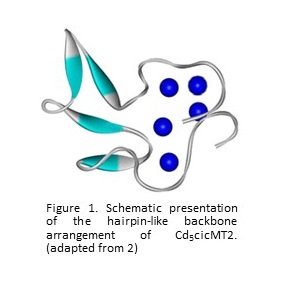Plant metallothionein 2 protein – following the metalation process
Metallothioneins (MTs) are low molecular weight (~8kDa), mostly cytosolic proteins involved in both essential metal homeostasis and a variety of stress responses. The MT2 protein from the plant Cicer arietinum (cicMT2) features two cysteine-rich regions with eight and six cysteine residues, respectively, which are separated by a 41 amino acids long, Cys-free linker region. It can coordinate five divalent metal ions in vitro. Previous results strongly suggest that the coordinated metal ions are arranged in a single metal-thiolate cluster leading to a hairpin-like protein fold.1,2 However, so far, the metalation pathway has never been investigated for any plant MT. In the presented study we focus on the identification of the binding region for each metal ion. Cluster formation upon stepwise metal ion reconstitution is monitored by changes in the ESI-MS profiles aided by limited proteolytic digestion with Tritirachium album proteinase K, which cleaves the protein backbone mainly in the Cys-free region. Identification of the binding region for each metal ion is complemented and corroborated by investigations with size exclusion chromatography, atomic absorption spectroscopy, and dynamic light scattering.

Project funding by the Swiss National Science Foundation (SNSF) to EF is gratefully acknowledged.
[1] Xiaoqiong Wan, Eva Freisinger, Metallomics, 2009, 1, 489-500.
[2] Eva Freisinger, J. Biol. Inorg. Chem., 2011, 16, 1035-1045.